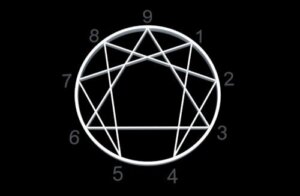The Child Enneagram: Discover What Your Child is Like

Personality, among other factors, makes two children raised in the same environment and by the same parents very different. So, how do we know what each one needs and how to accompany their growth? Keep reading to learn what the child enneagram is and how it can help you to know your child better.
Today, many parents use this tool to develop the most appropriate strategies to accompany the development and learning of their little ones, according to their characteristics and needs. If you want to know the advantages of incorporating this technique into your parenting, don’t miss the following information.
What’s the child enneagram?
The child enneagram proposes the existence of three types of brains, each of which contains 3 subtypes of personalities or enneatypes. Discover what they are below and determine which one describes your child.
Emotional Enneatypes
These are those who are characterized by “putting the heart before everything else” and are people who handle themselves with great empathy and sensitivity. In turn, there are 3 subtypes:
- Those who seek to be loved. These are those who are always oriented towards others and often forget about themselves. They seek affection and, therefore, are affectionate, close, and kind.
- Successful. They put in first place the image they project on others. This leads them to forget many times who they are, as they adjust to what they want to show. They’re tenacious, productive, and very sociable.
- Sensitive and long-suffering. They’re very vulnerable and susceptible to criticism. At the same time, they want to be special, so they’re creative in order to stand out.

Rational Enneatypes
Unlike emotional enneatypes, rational enneatypes are those who are guided by the head, that is, by thought. We’ll share with you the subtypes:
- Observers. They tend to be more introverted and prefer to be alone or in small, one-on-one interactions. They’re silent and like to maintain a certain distance. They sometimes have difficulty expressing their emotions.
- Insecure and hesitant. These are the ones who give more thought to a matter, as they need to feel secure before proceeding. For this reason, they’re sometimes very nervous. It’s very important to reinforce their self-esteem and let them know that they’re capable of achieving their goals.
- Energetic and enthusiastic. These are children who are always on the move. They never stop doing things because they want to enjoy themselves to the fullest. They’re outgoing and very sociable. Sometimes, they may also have difficulty concentrating.
Instinctive Enneatypes
Children that fall into this enneatype are rather impulsive and instinctive and within this group, we have three profiles:
- Perfectionists. They are two-sided: On the one hand, they try very hard to achieve what they want, but at the same time, they’re inflexible and rigid. They tend to be demanding and, at times, a bit authoritarian. This attachment to the rules and their fulfillment takes away a certain spontaneity and freshness from enjoying the achievements.
- Those who want to be in control. They’re authoritarian and powerful. They’re characterized by protecting those they consider to be weaker and are lovers of justice. At times, they can be vindictive, so it’s good to teach them about compassion. They’re loyal and devoted to those they trust.
- Conciliators and peacemakers. They’re not comfortable with conflict. They offer help to others, which is their “Achilles heel”. They must be taught to set limits, as they can sometimes exaggerate in their generosity.
You may be interested in: The Most Suitable Sport for Your Child According to Their Personality
Keys to keep in mind about the child enneagram
Like any tool, the child enneagram provides information about the strengths and weaknesses of each personality type. Hence, by knowing them, we can choose the best strategies to enhance the development of each child. However, it’s important to keep in mind that this evaluation doesn’t exhaust in itself the multiple facets and nuances that a person may have.
Likewise, it’s important to keep in mind that the influence of parenting and parental styles is also decisive in the development of the personality of children. In this regard, it’s always advisable to rethink one’s own actions.
You may be interested in: Strong-Willed Children: What You Need to Know

Good and bad, everything is relative
Finally, it’s very important to clarify the usefulness of the enneagram and the data it provides. All the information obtained from applying any technique should always be read in the light of the context and understand that this has a fundamental role in the life of any person.
At the same time, we must avoid settling into the types and subtypes so as not to make the mistake of believing that “everything has already been said” and that nothing can be changed. The information is intended to help us understand and better accompany our actions, rather than to function as an ultimatum.
Finally, we must consider the situational factor of certain attributes or behaviors. For example, feeling fear can be extremely useful in one context, such as being alert in the sea if we don’t know how to swim. But it can be detrimental in another, such as when it blocks us during a competition. In other words, a quality can be functional or dysfunctional, depending on the moment. For this reason, it’s a matter of finding how to make use of the information we have about ourselves and invite us to improve ourselves.
In short, personality development is much more than a series of characteristics, it’s the convergences of the individual and collective and also one’s context.
Personality, among other factors, makes two children raised in the same environment and by the same parents very different. So, how do we know what each one needs and how to accompany their growth? Keep reading to learn what the child enneagram is and how it can help you to know your child better.
Today, many parents use this tool to develop the most appropriate strategies to accompany the development and learning of their little ones, according to their characteristics and needs. If you want to know the advantages of incorporating this technique into your parenting, don’t miss the following information.
What’s the child enneagram?
The child enneagram proposes the existence of three types of brains, each of which contains 3 subtypes of personalities or enneatypes. Discover what they are below and determine which one describes your child.
Emotional Enneatypes
These are those who are characterized by “putting the heart before everything else” and are people who handle themselves with great empathy and sensitivity. In turn, there are 3 subtypes:
- Those who seek to be loved. These are those who are always oriented towards others and often forget about themselves. They seek affection and, therefore, are affectionate, close, and kind.
- Successful. They put in first place the image they project on others. This leads them to forget many times who they are, as they adjust to what they want to show. They’re tenacious, productive, and very sociable.
- Sensitive and long-suffering. They’re very vulnerable and susceptible to criticism. At the same time, they want to be special, so they’re creative in order to stand out.

Rational Enneatypes
Unlike emotional enneatypes, rational enneatypes are those who are guided by the head, that is, by thought. We’ll share with you the subtypes:
- Observers. They tend to be more introverted and prefer to be alone or in small, one-on-one interactions. They’re silent and like to maintain a certain distance. They sometimes have difficulty expressing their emotions.
- Insecure and hesitant. These are the ones who give more thought to a matter, as they need to feel secure before proceeding. For this reason, they’re sometimes very nervous. It’s very important to reinforce their self-esteem and let them know that they’re capable of achieving their goals.
- Energetic and enthusiastic. These are children who are always on the move. They never stop doing things because they want to enjoy themselves to the fullest. They’re outgoing and very sociable. Sometimes, they may also have difficulty concentrating.
Instinctive Enneatypes
Children that fall into this enneatype are rather impulsive and instinctive and within this group, we have three profiles:
- Perfectionists. They are two-sided: On the one hand, they try very hard to achieve what they want, but at the same time, they’re inflexible and rigid. They tend to be demanding and, at times, a bit authoritarian. This attachment to the rules and their fulfillment takes away a certain spontaneity and freshness from enjoying the achievements.
- Those who want to be in control. They’re authoritarian and powerful. They’re characterized by protecting those they consider to be weaker and are lovers of justice. At times, they can be vindictive, so it’s good to teach them about compassion. They’re loyal and devoted to those they trust.
- Conciliators and peacemakers. They’re not comfortable with conflict. They offer help to others, which is their “Achilles heel”. They must be taught to set limits, as they can sometimes exaggerate in their generosity.
You may be interested in: The Most Suitable Sport for Your Child According to Their Personality
Keys to keep in mind about the child enneagram
Like any tool, the child enneagram provides information about the strengths and weaknesses of each personality type. Hence, by knowing them, we can choose the best strategies to enhance the development of each child. However, it’s important to keep in mind that this evaluation doesn’t exhaust in itself the multiple facets and nuances that a person may have.
Likewise, it’s important to keep in mind that the influence of parenting and parental styles is also decisive in the development of the personality of children. In this regard, it’s always advisable to rethink one’s own actions.
You may be interested in: Strong-Willed Children: What You Need to Know

Good and bad, everything is relative
Finally, it’s very important to clarify the usefulness of the enneagram and the data it provides. All the information obtained from applying any technique should always be read in the light of the context and understand that this has a fundamental role in the life of any person.
At the same time, we must avoid settling into the types and subtypes so as not to make the mistake of believing that “everything has already been said” and that nothing can be changed. The information is intended to help us understand and better accompany our actions, rather than to function as an ultimatum.
Finally, we must consider the situational factor of certain attributes or behaviors. For example, feeling fear can be extremely useful in one context, such as being alert in the sea if we don’t know how to swim. But it can be detrimental in another, such as when it blocks us during a competition. In other words, a quality can be functional or dysfunctional, depending on the moment. For this reason, it’s a matter of finding how to make use of the information we have about ourselves and invite us to improve ourselves.
In short, personality development is much more than a series of characteristics, it’s the convergences of the individual and collective and also one’s context.
All cited sources were thoroughly reviewed by our team to ensure their quality, reliability, currency, and validity. The bibliography of this article was considered reliable and of academic or scientific accuracy.
- Valdivia Salas, Sonsoles Luciano Soriano, María Carmen Gómez Becerra, Inmaculada. Consideraciones sobre el desarrollo de la personalidad desde un marco funcional-contextual (2002). International journal of psychology and psychological therapy Vol. 2 Núm. 2 Pág. 173-197
-
Núñez G., C., & Serpa B., A. (2015). Aproximaciones a los tipos de personalidad según el Eneagrama. PsiqueMag, 4(1), 45–57. https://doi.org/10.18050/psiquemag.v4i1.113
This text is provided for informational purposes only and does not replace consultation with a professional. If in doubt, consult your specialist.








